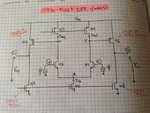furiaceka
Newbie level 3
Hi,
I have this type of circuit to analyze:

1) What is the kind of topology of this circuit? because it is similar to a OTA fully diff but there are 2 differential pairs(M7-M8 and M1-M2), one with Vo and another with differential and common input
2) What is the differential gain Ad?
if you have any link with explanation of this circuit I'm very happy to read it.
I have this type of circuit to analyze:

1) What is the kind of topology of this circuit? because it is similar to a OTA fully diff but there are 2 differential pairs(M7-M8 and M1-M2), one with Vo and another with differential and common input
2) What is the differential gain Ad?
if you have any link with explanation of this circuit I'm very happy to read it.
